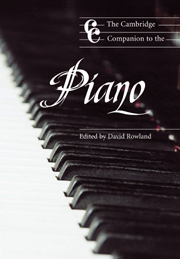Book contents
2 - Pianos and pianists c.1770–c.1825
from Part one - Pianos and pianists
Published online by Cambridge University Press: 28 September 2011
Summary
In 1830 Friedrich Kalkbrenner (1785–1849) wrote:
The instruments of Vienna and London have produced two different schools. The pianists of Vienna are especially distinguished for the precision, clearness and rapidity of their execution; the instruments fabricated in that city are extremely easy to play, and, in order to avoid confusion of sound, they are made with mufflers [dampers] up to the last high note; from this results a great dryness in sostenuto passages, as one sound does not flow into another. In Germany the use of the pedals is scarcely known. English pianos possess rounder sounds and a somewhat heavier touch; they have caused the professors of that country to adopt a grander style, and that beautiful manner of singing which distinguishes them; to succeed in this, the use of the loud pedal is indispensable, in order to conceal the dryness inherent to the pianoforte.
His remarks could easily have been made twenty or thirty years previously, since his description summarises – albeit in a highly generalised fashion – so many of the essentials of piano making and playing for much of the period covered by this chapter.
‘Viennese’ and English grand pianos
Most English grand pianos of the late eighteenth century look much like the Backers grand of 1772, illustrated in Fig. 1.5. The anonymous and undated grand of Fig. 2.1 is typical of instruments made in the last two decades of the eighteenth century in southern Germany and Austria (generally referred to as ‘Viennese’ pianos). These two instruments therefore illustrate the essential differences in appearance of pianos by members of the English and ‘Viennese’ schools.
- Type
- Chapter
- Information
- The Cambridge Companion to the Piano , pp. 22 - 39Publisher: Cambridge University PressPrint publication year: 1998



